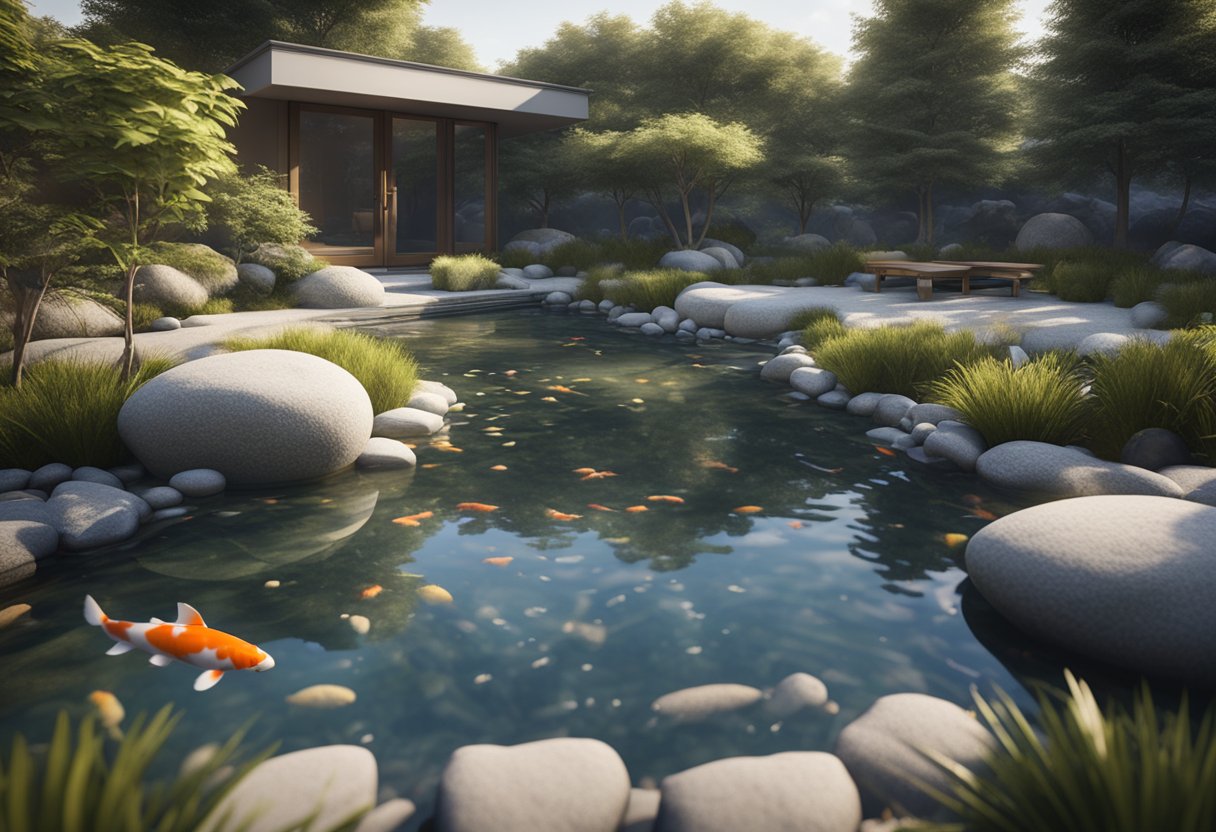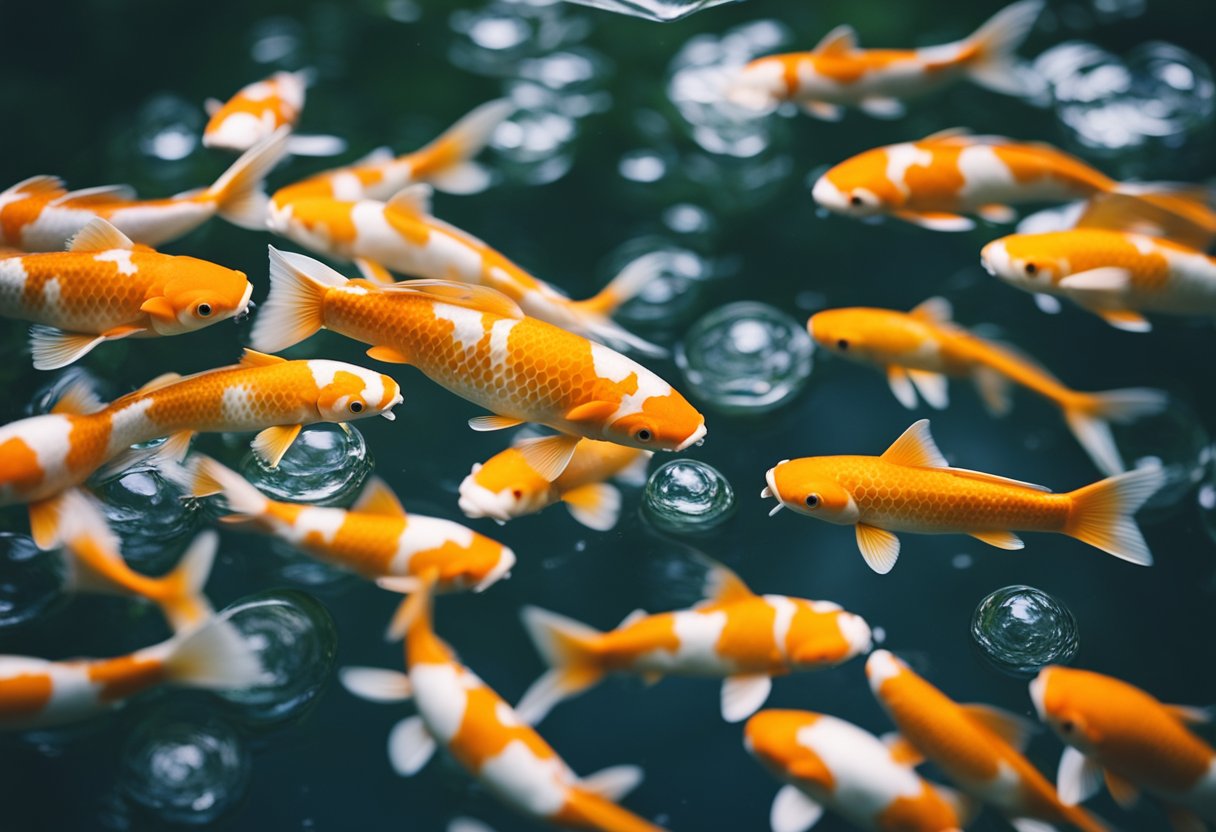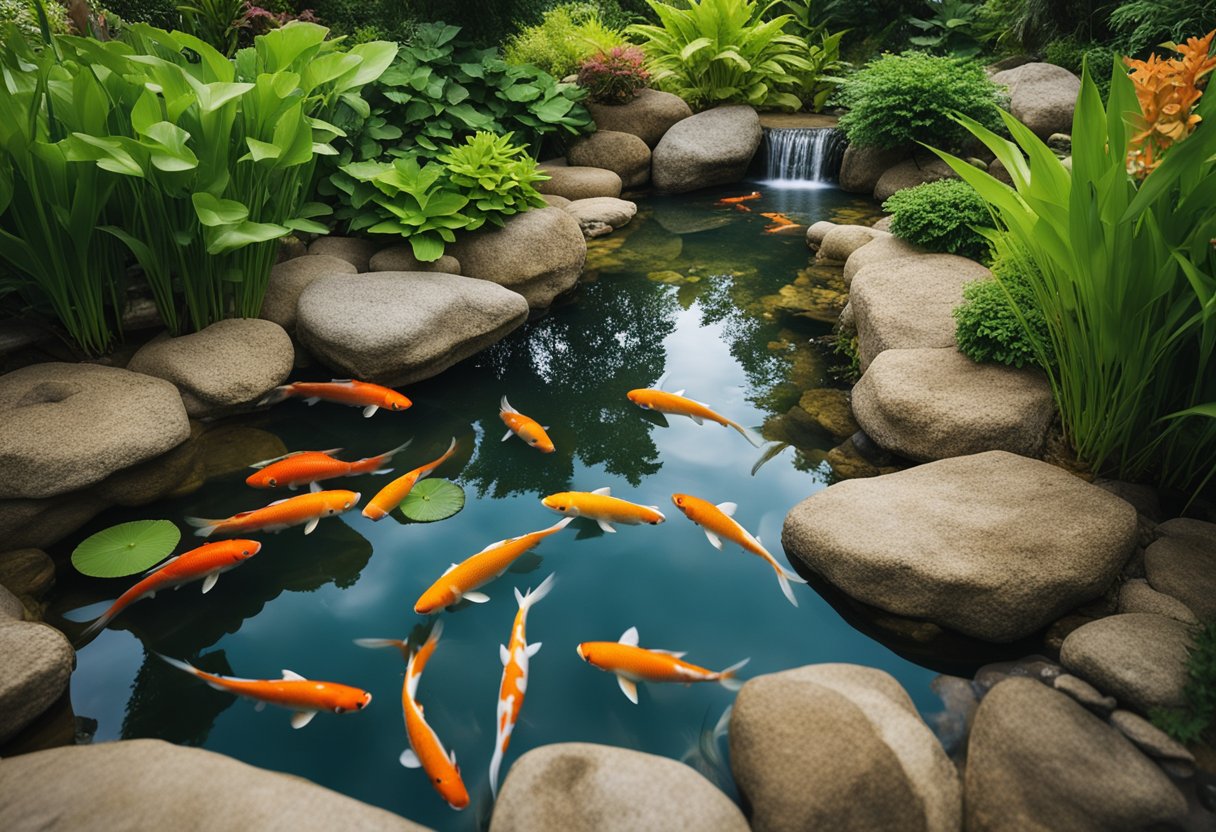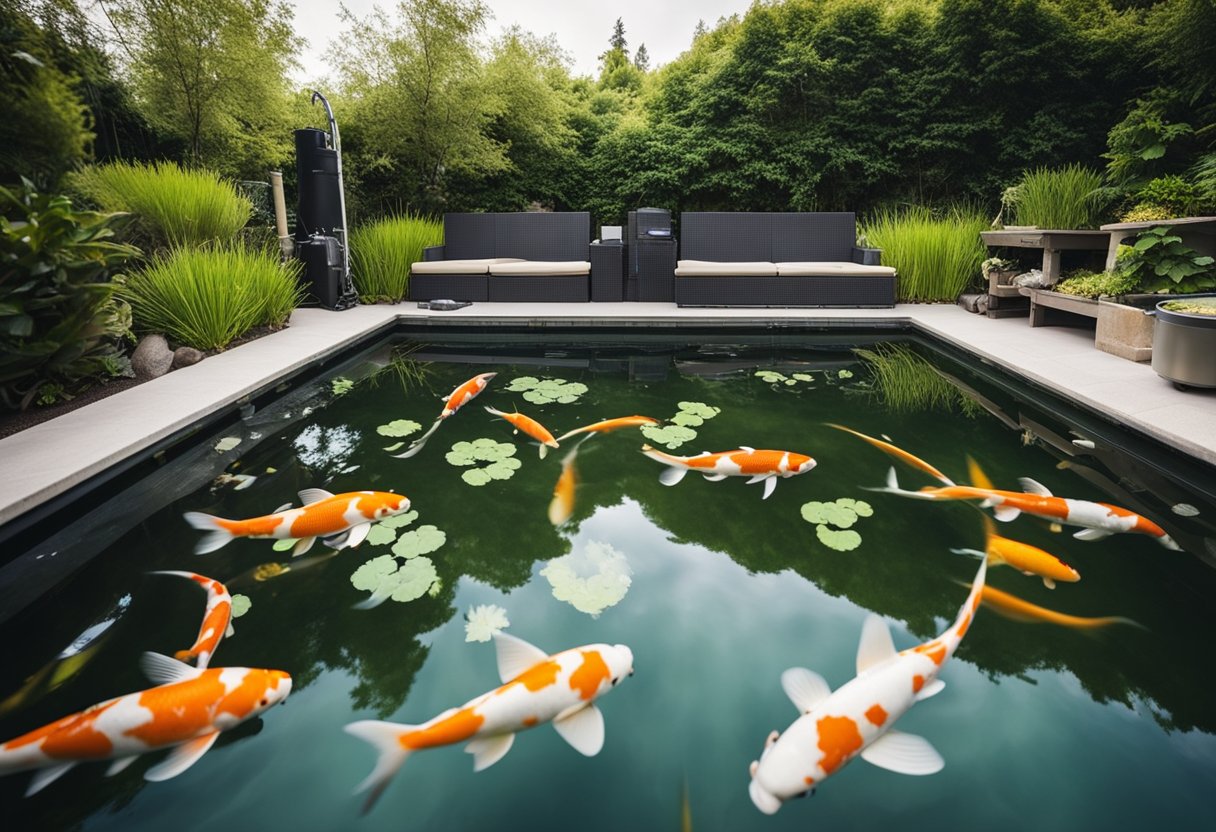Koi Pond Aquatic Habitat Creation Essentials
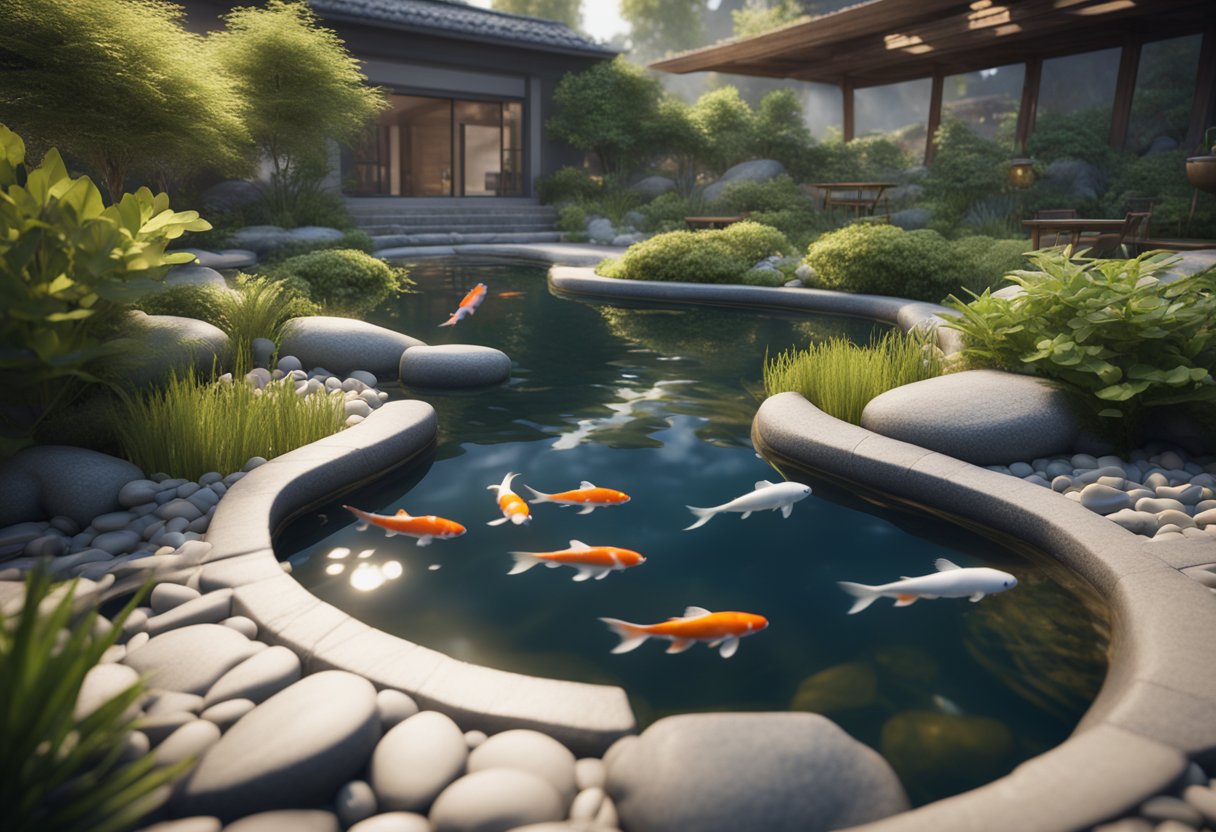
Pond Cleaning and Maintenance Schedule
Regular cleaning and maintenance are essential for the longevity of your fish pond. Develop a cleaning and maintenance schedule that includes tasks such as removing debris, trimming plants, and inspecting equipment. In general, a quarterly or semi-annual deep cleaning is recommended to ensure a healthy and aesthetically pleasing pond.
| Maintenance Tasks | Frequency |
|---|---|
| Removing debris | Weekly |
| Water testing | Monthly |
| Filter cleaning | Every 3 months |
| Deep cleaning | Every 6 months |
By following these fish pond maintenance practices, you can create an optimal environment for your koi fish to thrive. A healthy fish pond not only provides beauty and tranquility but also ensures the well-being of your aquatic companions.
Developing a Sustainable Pond Ecosystem
Creating a balanced and self-sustaining ecosystem is crucial for the long-term success of your koi fish pond. By following these important steps, you can establish a healthy habitat for your fish and other pond inhabitants, promoting their well-being and enhancing the overall beauty of your pond.
1. Establishing Beneficial Bacteria
Beneficial bacteria play a crucial role in maintaining water quality and breaking down organic waste in your pond. These bacteria help prevent the accumulation of harmful substances and ensure a stable environment for your koi fish. To promote the growth of beneficial bacteria, it is essential to establish a proper biological filtration system and regularly monitor water parameters.
2. Managing Algae Growth
Algae growth is a natural part of any aquatic ecosystem, but excessive algae can disrupt the balance of your pond and negatively impact water quality. To manage algae growth, consider incorporating plants that compete with algae for nutrients and shade the water surface to limit sunlight penetration. Additionally, maintaining a balanced fish population and proper nutrient management can help prevent algae blooms.
3. Supporting Habitat Diversity
A diverse habitat is essential for the health and well-being of your pond inhabitants. Incorporate a variety of aquatic plants, such as submerged plants, floating plants, and marginal plants, to provide shelter, food sources, and hiding places for your fish. Additionally, consider adding rocks, logs, and other natural elements to create additional habitat niches and promote biodiversity.
4. Monitoring Water Quality
Regular monitoring of water quality parameters is crucial for maintaining a healthy pond ecosystem. Test the pH, ammonia, nitrite, and nitrate levels regularly to ensure they remain within the acceptable range for your koi fish. Make necessary adjustments by adding dechlorinator or performing partial water changes to maintain optimal water conditions.
5. Proper Fish Feeding
Feeding your koi fish a balanced diet is important for their health and for preventing excess fish waste in the pond. Feed your fish a high-quality, nutritionally balanced diet in appropriate quantities. Overfeeding can lead to water quality issues and increased algae growth, so it’s important to feed your fish only what they can consume within a few minutes.
6. Maintaining Water Circulation
Proper water circulation is essential for maintaining overall pond health. It helps distribute oxygen throughout the water, prevents stagnant areas, and aids in filtration. Consider adding a fountain, waterfall, or aeration system to enhance water movement and oxygenation in your pond.
7. Regular Pond Maintenance
To ensure the long-term health of your pond ecosystem, regular maintenance is required. This includes removing debris, dead leaves, and excess organic matter from the pond, as well as trimming and thinning plants as needed. Routine maintenance tasks also include inspecting and cleaning filters, checking equipment, and repairing any leaks or malfunctions.
By following these guidelines, you can create a sustainable pond ecosystem that supports the health and vitality of your koi fish and other pond inhabitants. Establishing beneficial bacteria, managing algae growth, promoting habitat diversity, monitoring water quality, proper fish feeding, maintaining water circulation, and regular maintenance are all essential steps to ensure a thriving and beautiful pond for years to come.
Looking to add more than just koi fish to your pond? In this section, you will learn how to design and install a water garden that incorporates a variety of aquatic plants and wildlife, creating a beautiful and diverse outdoor space.
Designing a Water Garden
When designing your water garden, consider the following:
- Placement: Choose a location that receives adequate sunlight for the plants to thrive, but also provides some shade to prevent excessive algae growth.
- Size and Shape: Determine the size and shape of your water garden based on the available space in your pond. Consider incorporating curves and different depths to enhance visual interest.
- Plant Selection: Research and select a variety of aquatic plants that are compatible with your pond’s water quality and temperature. Aim for a mix of floating, submerged, and marginal plants to create a balanced ecosystem.
- Wildlife Considerations: Be mindful of the wildlife you wish to attract to your water garden. Choose plants that provide food and shelter for local birds, butterflies, and other beneficial insects.
Water Garden Installation
Follow these steps for a successful water garden installation:
- Prepare the Area: Clear the area of any debris or vegetation that may interfere with the installation. Remove rocks and level the surface for proper plant placement.
- Lay a Protective Liner: Use a pond liner to create a barrier between the soil and water, preventing leaks and maintaining the water garden’s structure. Ensure proper placement and secure the liner in place.
- Fill with Water: Slowly fill the water garden, taking care not to disturb the plants or liner. Add dechlorinator if necessary to remove harmful chemicals from tap water.
- Plant Arrangement: Arrange the aquatic plants according to their preferred depth and spacing requirements. Use plant baskets or plant directly into gravel or soil to secure them in place.
- Introduce Wildlife: Once the water garden is set up, gently introduce aquatic wildlife such as snails, frogs, or small fish. Ensure the compatibility of the wildlife with the plants and your existing koi fish.
By following these steps, you can create a captivating water garden that complements your koi pond and adds a touch of natural beauty to your outdoor space.
| Benefits of a Water Garden | Benefits of a Water Garden |
|---|---|
| Enhances biodiversity of the pond | Increases aesthetic appeal |
| Provides shelter and food for wildlife | Offers opportunities for educational experiences |
| Helps maintain a balanced ecosystem | Creates a relaxing and peaceful environment |
Managing Your Outdoor Pond
Owning an outdoor pond comes with its own set of responsibilities. To ensure the health and longevity of your pond, it’s essential to practice effective outdoor pond management throughout the year. By following these valuable insights, you can maintain proper water levels, prevent common issues, and prepare your pond for the winter season.
Maintaining Proper Water Levels
One of the key aspects of outdoor pond management is maintaining proper water levels. It’s important to regularly check and adjust the water level to ensure optimal conditions for your pond’s ecosystem. Evaporation and splashing from water features can lead to a decrease in water levels over time.
Avoid overfilling the pond as it can cause the water to overflow and disrupt the surrounding landscape. Conversely, low water levels can lead to poor oxygen circulation and affect the health of your fish and plants. Regularly monitor the water level and make adjustments as needed.
Preventing Algae Growth
Algae growth is a common challenge in outdoor ponds. Excessive algae can affect water quality, reduce oxygen levels, and create an unsightly appearance. To manage algae growth effectively, consider the following steps:
- Ensure proper water circulation and aeration to discourage algae growth.
- Introduce aquatic plants that compete with algae for nutrients and sunlight.
- Regularly remove excess debris, such as fallen leaves and twigs, from the pond.
- Consider adding beneficial bacteria or algae control products to maintain a healthy balance.
Winterizing Your Pond
Preparing your outdoor pond for the winter season is crucial to protect your fish and plants from cold temperatures and ice formation. Winterizing your pond involves several steps, including:
- Clean and remove any debris from the pond before the onset of winter.
- Trim back and remove dying aquatic plants to prevent decay during the winter.
- Consider installing a pond heater or de-icer to prevent the formation of ice and ensure oxygen exchange.
- Remove fish from the pond and transfer them to a suitable indoor environment, if necessary.
- Protect the pond’s filtration system by draining and storing it properly.
By following these winterization steps, you can help your pond survive the colder months and ensure a healthy start to the next season.
Pond Maintenance Checklist
| Monthly | Quarterly |
|---|---|
| Clean and replace filters | Inspect and repair any leaks |
| Prune and trim aquatic plants | Check and clean water features |
| Test and adjust water chemistry | Remove excess debris |
| Monitor and adjust water levels | Apply beneficial bacteria or pond treatments |
Designing a Serene Backyard Pond
Transform your backyard into a tranquil retreat with the perfect pond design. Whether you’re seeking a peaceful space to unwind or a stunning focal point for your outdoor area, creating a backyard pond can elevate the ambiance of your surroundings. By considering different styles, material choices, and landscaping techniques, you can cultivate a harmonious and relaxing outdoor space that suits your taste and lifestyle.
Styles
When designing a backyard pond, it’s essential to choose a style that complements your landscape and personal preferences. Here are a few popular styles to consider:
- Formal pond: This style features clean lines, symmetrical shapes, and often incorporates geometric designs. It creates a structured and refined aesthetic suitable for formal gardens.
- Naturalistic pond: Mimicking the look of a natural water feature, this style emphasizes irregular shapes, organic materials, and a variety of plants to create a harmonious blend with the surrounding environment.
- Asian-inspired pond: Inspired by traditional Japanese gardens, this style features elements such as bamboo, ornamental bridges, and carefully sculpted rocks. It creates a serene and Zen-like atmosphere.
Materials
The choice of materials plays a significant role in the overall design and durability of your backyard pond. Consider these options:
- Preformed pond liners: These rigid, pre-molded liners are easy to install and come in various shapes and sizes. They offer a quick and convenient solution for beginners or those looking for a hassle-free installation process.
- Flexible pond liners: Made of rubber or PVC, these liners provide more design flexibility as they can be customized to fit any shape or size. They are ideal for creating unique and organic forms that blend seamlessly with your landscape.
- Natural stones: Incorporating natural stones such as flagstone or slate around the edges of your pond adds an organic and visually appealing element. These stones also provide an ideal surface for beneficial bacteria to colonize.
Landscaping Techniques
The right landscaping techniques can enhance the beauty and functionality of your backyard pond. Here are some ideas to consider:
- Aquatic plants: Adding a variety of aquatic plants, such as water lilies, lotuses, and marginal plants, not only adds visual interest but also helps to create a balanced ecosystem by providing shade and oxygenating the water.
- Rockwork: Incorporating strategically placed rocks and boulders around your pond can create natural-looking cascades, caves, and hiding places for fish. It also adds texture and dimension to the overall design.
- Lighting: Installing underwater or landscape lighting can dramatically transform the ambiance of your backyard pond, highlighting its features and creating stunning visual effects, especially at night.

